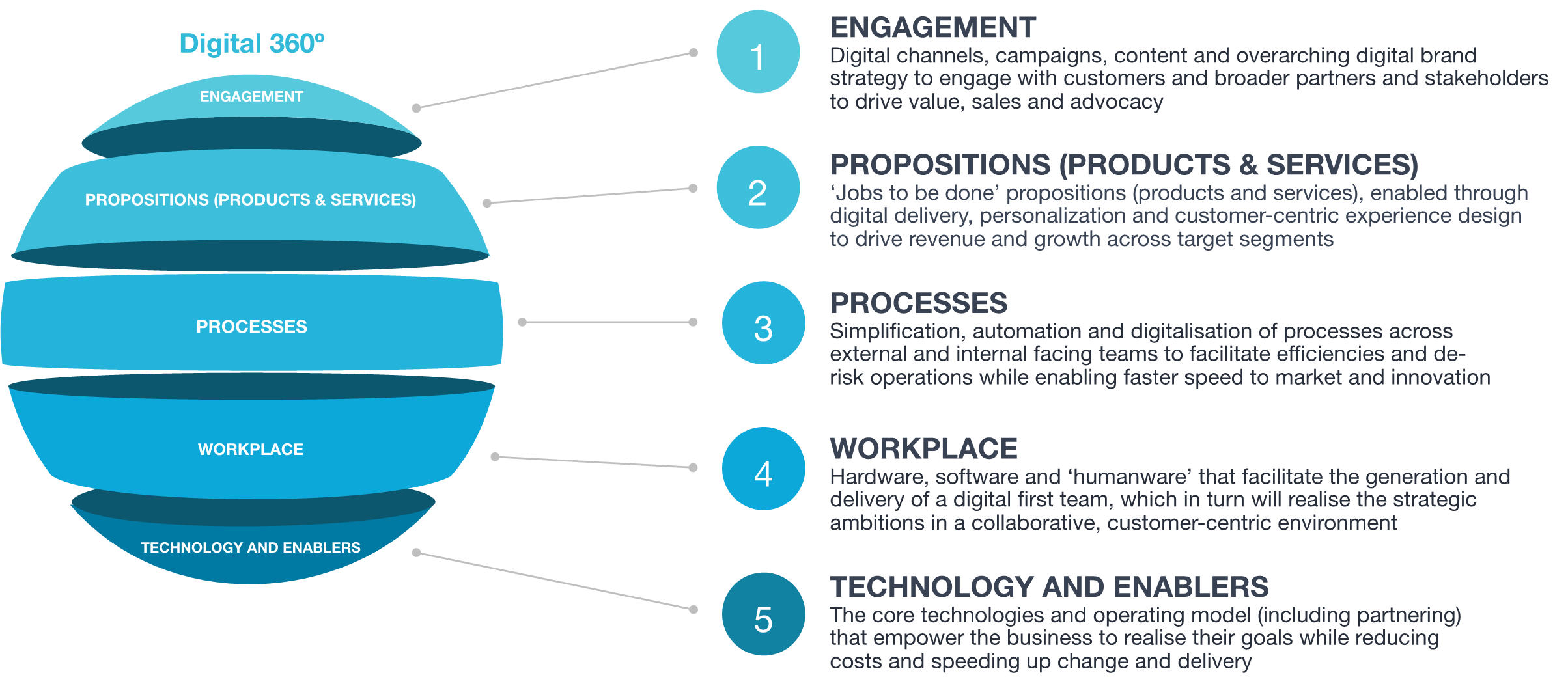Reclaiming the ‘Transformation’ Title:
If the Olympic Games handed out medals for buzzwords, ‘digital transformation’ would surely bring home the gold. However, the ubiquitous overuse of the term has also removed all clarity from the concept. It doesn’t matter who is to blame, though software vendors and marketing overlords selling digital transformation as the stairway to heaven do look a little guilty. What is important is that we reclaim digital transformation from its superficial buzzword status and fully understand why and, most importantly, how.
Full Contact – Not A Spectator Sport
One of the first pre-conceptions about digital transformation is that it arrives in the cloud, in a box, through an app or in lines of code. While technology solutions play a part, they don’t deliver digital transformation on their own (far from it) but are critical enablers in conveying a modern strategy and ambition.
Nor does digital transformation arrive on a PowerPoint deck from a strategy guru or a social media article. One must imagine it, develop it, and make it happen – for your customers, your market and your context.
Digital transformation involves a fundamental rethink of how organisations make use of people, processes and technology to improve performance. It is a complete change in how your organisation develops and delivers value to your customers, colleagues and investors. Organisations that truly want to embark on a digital transformation strategy start and end with the customer, creating a working environment that nurtures creativity, drives growth and delivers new arcs of value.
The 360° Approach
Figure 1 depicts a 360° approach to digital transformation, split across five layers. At the core are the processes, which enable the revenue-creating propositions (features, products and services) that are brought to market through the engagement layer. The workplace is the people, tools and environment harnessed to create those propositions, with underpinning technology making it all possible.
FIGURE1: 360° approach to digital transformation
 Processes are at the epicentre of transformation. This is where what is required to deliver your products and services is hard-coded. Therefore, this is also where the costs lie and risks exist. Taking out unnecessary steps (simplification), automating steps through low-cost, mature technologies such as robotics and then digitising value chains end-to-end is a great place to start the transformation. Does this mean it’s not about the customer? Of course not. Listening to what your customers and colleagues say about where the friction lies should drive the change.
Processes are at the epicentre of transformation. This is where what is required to deliver your products and services is hard-coded. Therefore, this is also where the costs lie and risks exist. Taking out unnecessary steps (simplification), automating steps through low-cost, mature technologies such as robotics and then digitising value chains end-to-end is a great place to start the transformation. Does this mean it’s not about the customer? Of course not. Listening to what your customers and colleagues say about where the friction lies should drive the change.
The most successful transformations start by reducing unnecessary ‘effort’ anchored in processes, and retiring whole products and services that don’t add, or even destroy, value. This not only improves the customer and employee experience (assuming you hold everyone’s hand through the change curve), but also reduces risk and releases capacity for the innovation of new propositions – constellations of products and services that fulfil customers’ desires, developed from customer insights leveraged from process-transformation analysis, and informed by techniques such as design thinking and the value proposition canvas.
Digitising value chains also facilitates the capture of data, the fuel that powers continuous improvement programmes and the application of artificial intelligence (AI). Combining new data with AI can support a step-change in the personalisation of marketing and improve sales-funnel conversion, automate back-office processing, and support channels in becoming faster and more efficient for the customer.
Executing process transformation also offers brands a range of points with which they can tell the story of change, of building a better business, of listening to customers and responding to needs – message opportunities often overlooked in the transformation trenches.
The Workplace and Technology
Empowering colleagues with the right tools and environment, and enough time to manage the complexities across the transformation layers, is fundamental to the optimum workplace. Harnessing the team’s insights and motivation, and liberating them to make customer-oriented improvements, is the defining prerequisite.
Creating the enabling conditions for such a journey requires strong foundations, and here’s where technology fits in – not last on the list by any means. Technologists and leaders who immerse themselves in the process, proposition, engagement and workplace layers can then determine the technology required, and the operating model needed, to deliver successful transformation and a thriving organisation.
The Customer is the Touchstone
Knowing that you need to implement a digital transformation on this scale is one thing, but where to begin is quite another. Embarking on such a monumental organisational shift can be extremely challenging for even the most experienced leaders.
To find a good starting point, become deeply knowledgeable about what your customers want to achieve when they engage with you, about their ‘jobs to be done’. It is not only the marketeers who should have such insight into the customer experience; everyone involved in digital transformation needs to have a forensic understanding of the customer and how your business does (or does not) facilitate them.
Knowing what you want digital transformation to achieve for your customers, you now need to really roll up your sleeves and ask:
- are large organisational changes necessary?
- do teams require reskilling and re-orientating?
- do hard re-prioritisation decisions need to be made?
You will most likely answer ‘yes’, but beware of procrastination; the time to start is now. Mobilise the effort by making the desire for better customer outcomes the focus. The customer guiding you on ‘what to do and why’ must be the unequivocal and undeniable touchstone to motivate, guide and, if required in the transformation haze, reset the mission at hand.
Getting Digital Transformation Right
Since successful digital transformation is a 360° endeavour, spanning the breadth and depth of the business, each organisation’s roadmap will be different. That said, there are some common principles to abide by:
- Gain consensus from the whole team: whether your project/programme involves building the new or enhancing the existing, it’s imperative to have buy-in from everyone involved, leveraging the customer as the touchstone and data as the tinder.
- Embrace the unknown with adaptive design: embracing an adaptive design and project management approach allows for tweaks to be made to the transformation strategy as needs arise – and they will arise. Remember, you’re building your transformation strategy around humans (customers, colleagues and investors) and humans don’t act in linear and predictable ways.
- De-risk: delivering transformation and building a customer-centric organisation involves taking more than a few risks. Communicate the ambition and the stretch outcomes you’re working towards. Then de-risk by managing the change activity in sprints of two to three weeks. This supports decision-making, seeing progress or calling failure early and learning quickly. Leaders should allow teams to ‘learn as they do’ and build an environment of self-sufficient innovation. In the long-term, this is a great de-risker: smaller projects equate to smaller risks.
- Initiate and react: Amazon’s game-changing ‘one-click economy’ has put just about every other industry into reaction mode, attempting to catch up with customers’ expectations. But that doesn’t mean that your whole transformation strategy should be a reactive response to the wider e-commerce forces at play. Get ahead of the game with pre-emptive or first-strike moves to truly future-proof your organisation. Larger, well-resourced organisations that are good at this often use game theory exercises; for smaller organisations, less elaborate scenario planning activities can be equally effective.
Is it that easy?
If it were that easy, everyone would have done it. Most organisations are trying and a few are thriving; some are just embarking and starting to grind it out, while only a few have yet to begin. But let’s be honest, it isn’t easy. It takes years. It takes vision. It takes resilience and it takes persistence. But it is necessary, and it is defining. As Albert Einstein said, “In the middle of difficulty lies opportunity”.
This article was written for Chartered Accounts Ireland, and published in Accountancy Ireland on 10th February 2020

